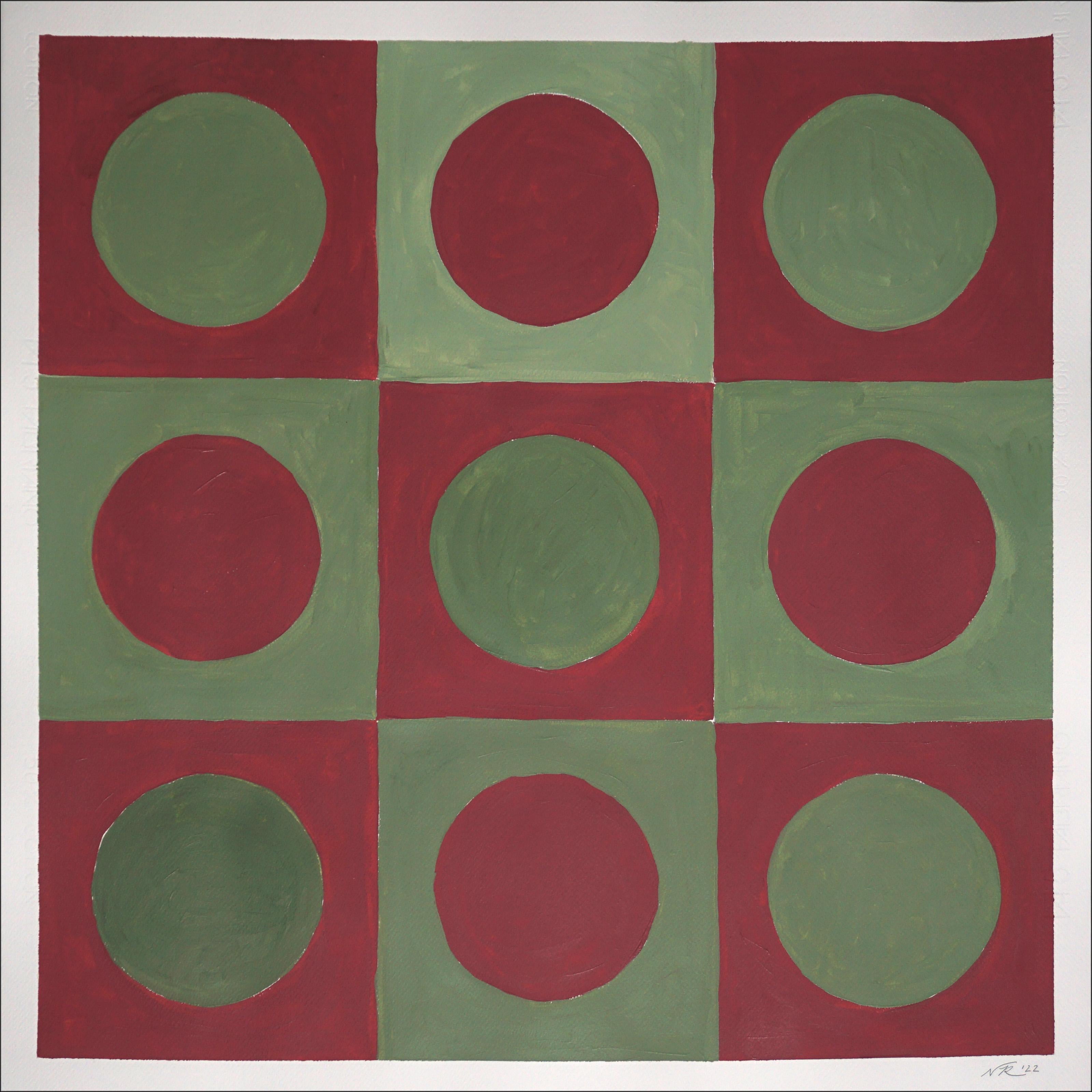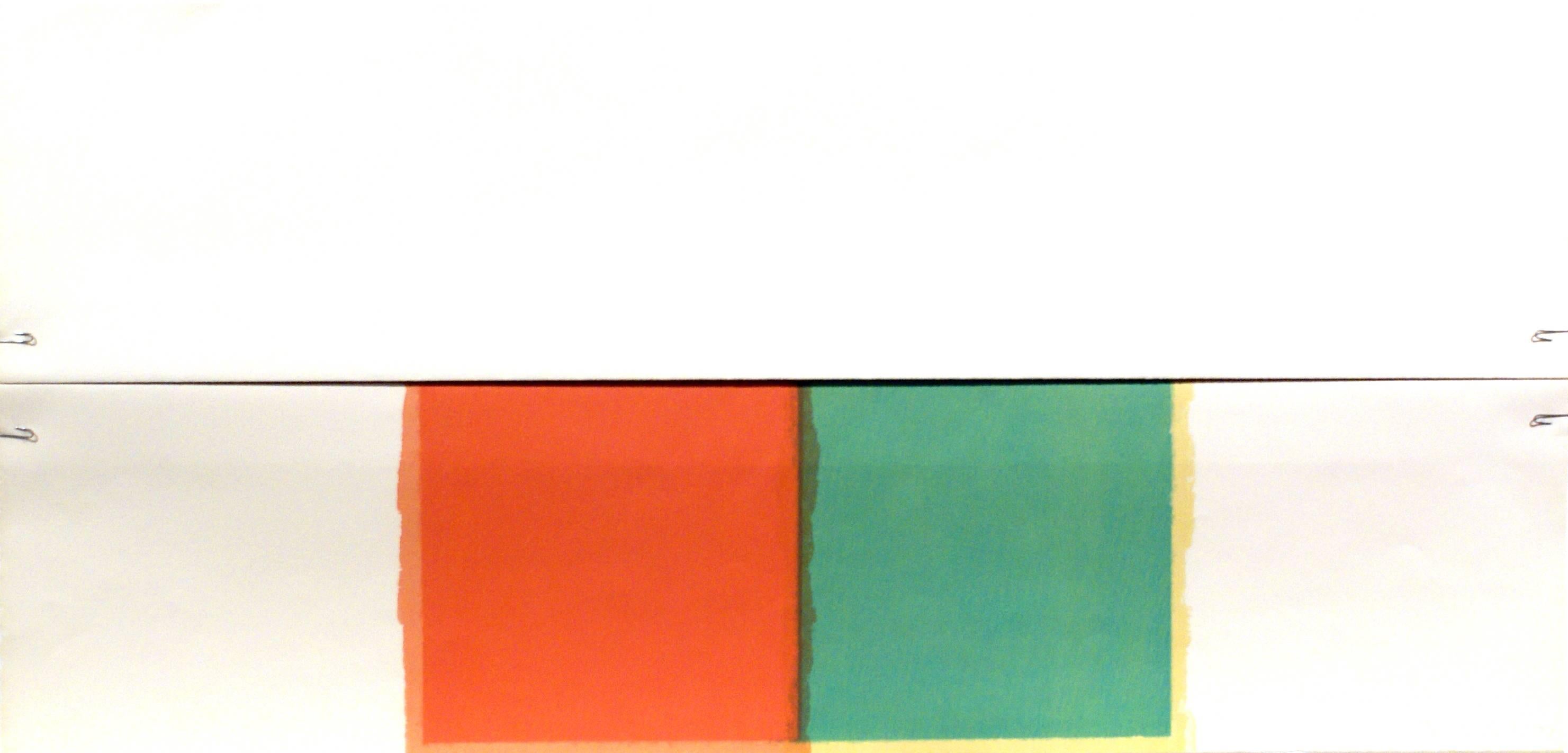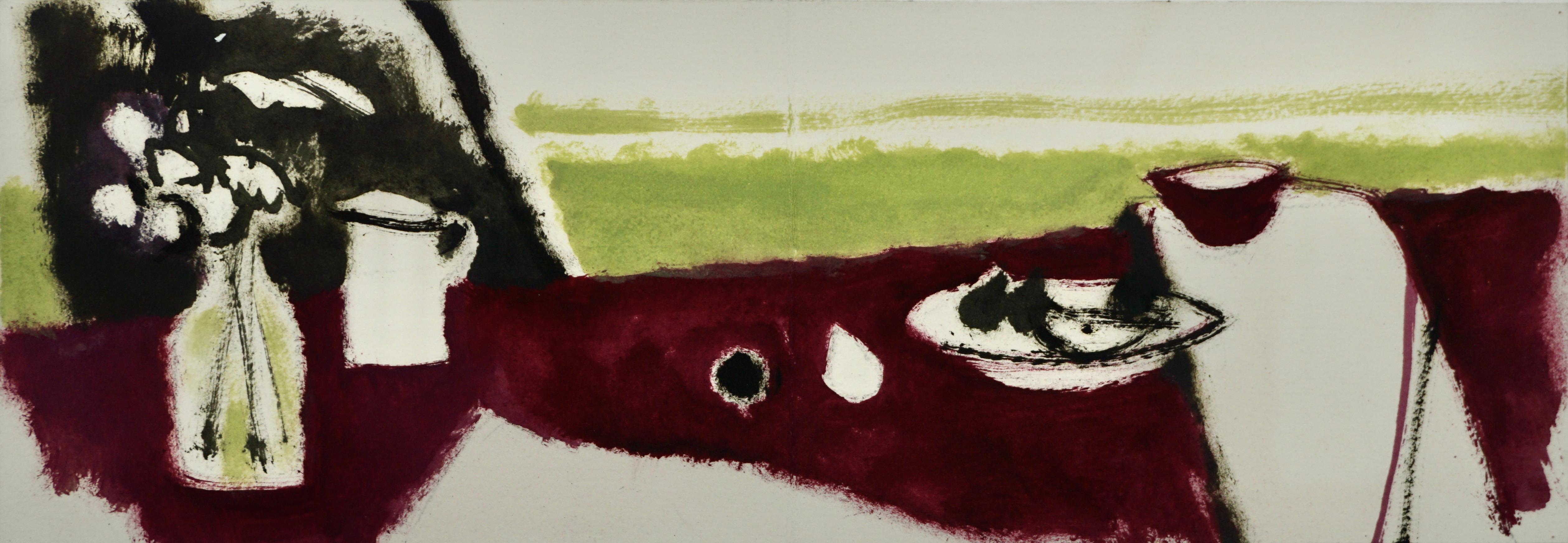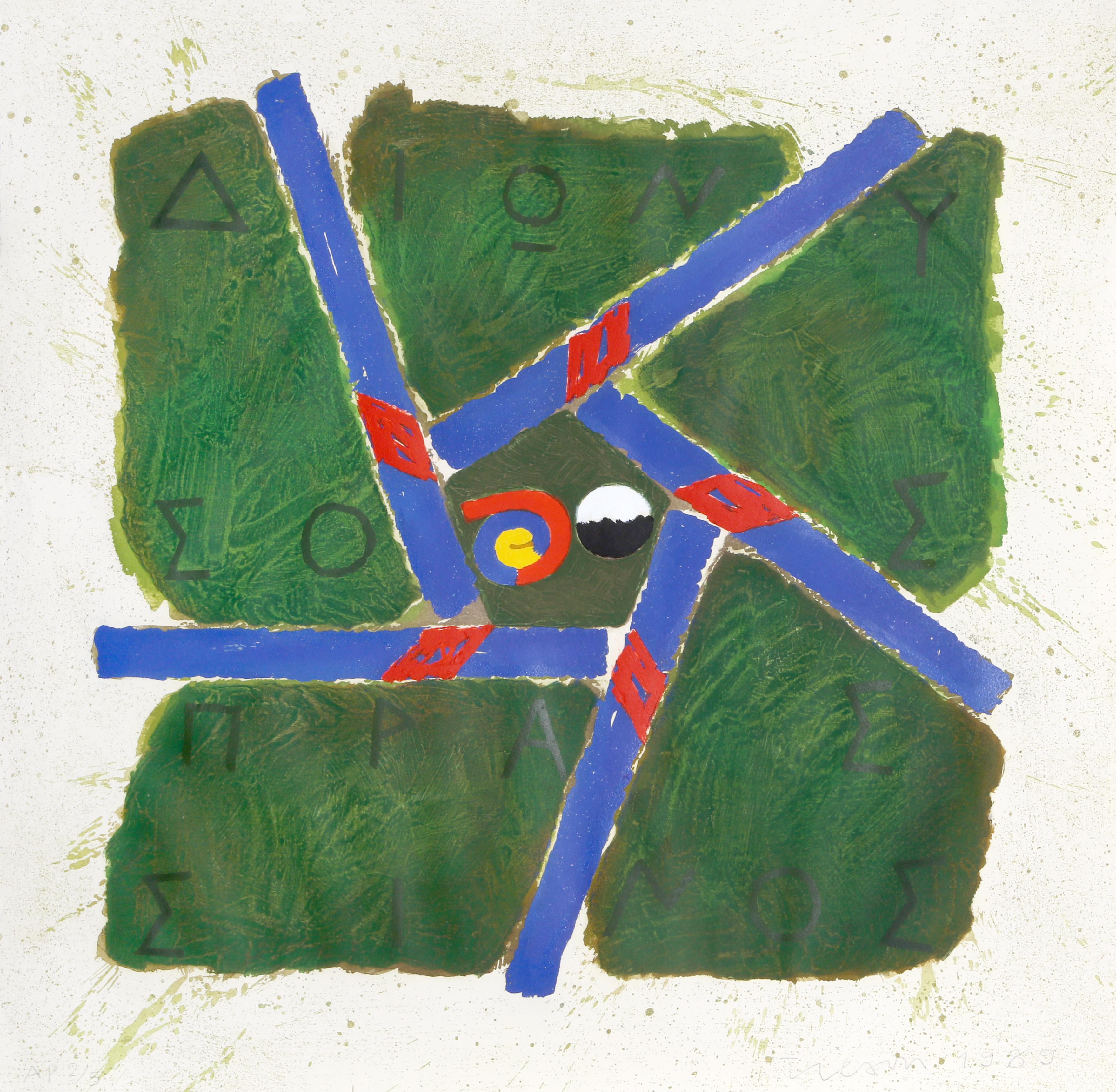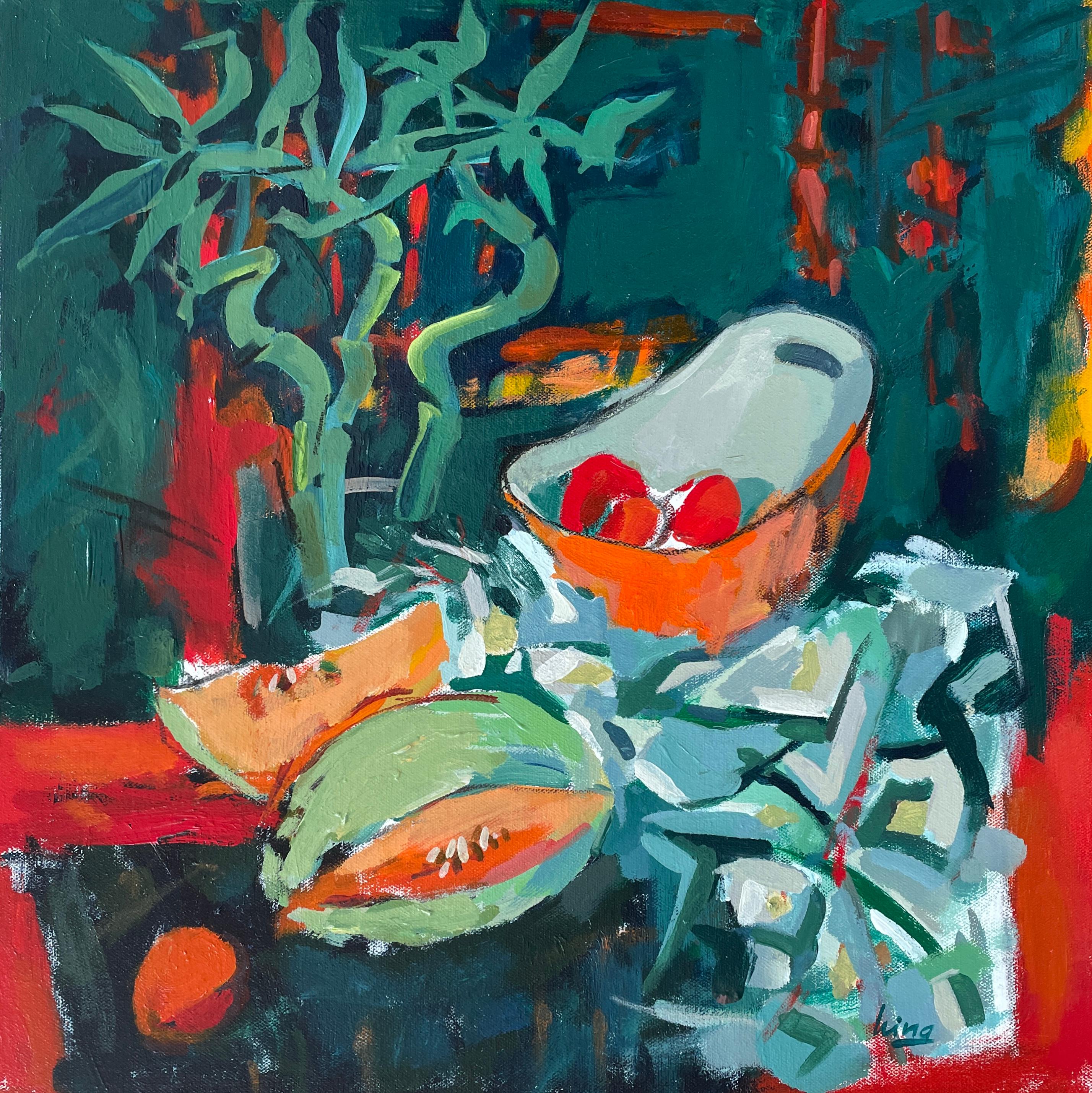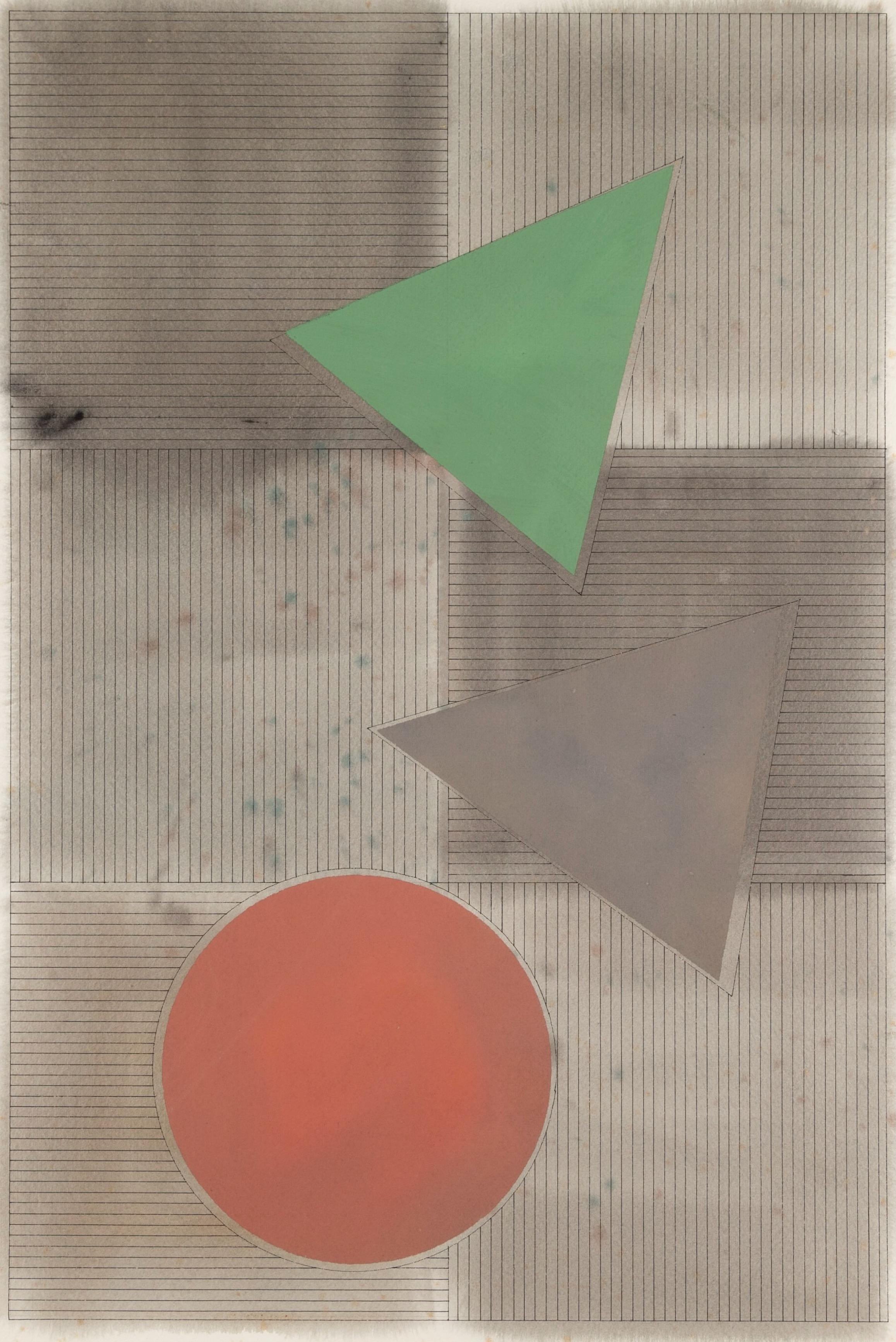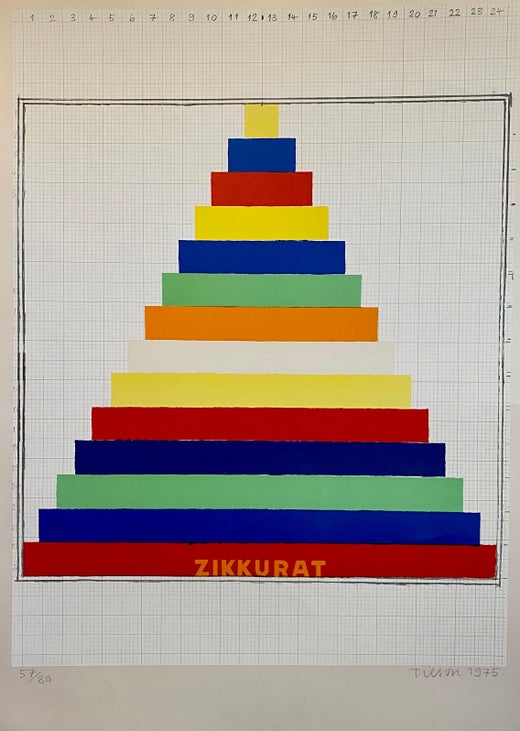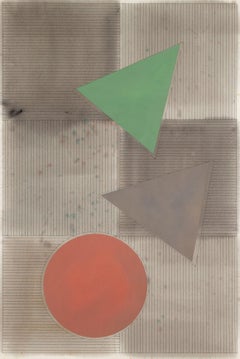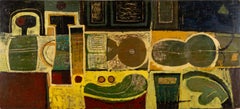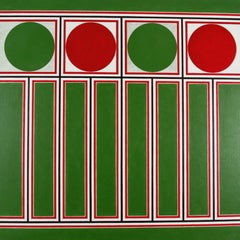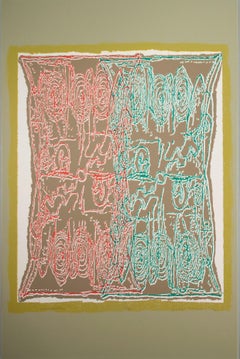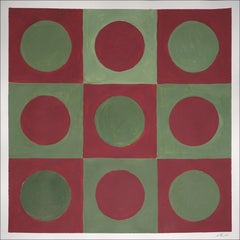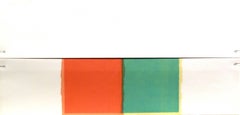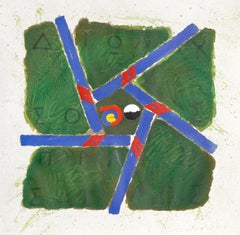Items Similar to Liknon, Graphic Still Life Print with Dice and Leaf, in Red and Green, 1994
Want more images or videos?
Request additional images or videos from the seller
1 of 6
Joe TilsonLiknon, Graphic Still Life Print with Dice and Leaf, in Red and Green, 19941994
1994
$3,766.96
£2,750
€3,240.70
CA$5,176.01
A$5,792.93
CHF 3,023.46
MX$70,643.90
NOK 38,696.24
SEK 36,630.94
DKK 24,184.93
Shipping
Retrieving quote...The 1stDibs Promise:
Authenticity Guarantee,
Money-Back Guarantee,
24-Hour Cancellation
About the Item
Liknon by Joe Tilson, 1994
Additional information:
Medium: screenprint, woodblock and etching on BFK Rives paper
57.1 x 76.2 cm
22 1/2 x 30 in
signed, dated, numbered II/XXV and inscribed 'For Penny & Michael - with all best wishes, Joe' in pencil; titled and dated in pencil verso
After serving in the Royal Air Force (1946–49), Tilson studied at St Martin's School of Art (1949–52) and the Royal College of Art (1952–55) where he received the Rome Prize, taking him to live in Italy in 1955. He returned to London in 1957, and from 1958 to 1963 he taught at St Martin's and subsequently taught at the Slade School of Fine Art, University College London, and Kings College, Newcastle upon Tyne, before moving to The School of Visual Arts, New York and then Hochschule fur Bildende Kunste, Hamburg.In 1961 he exhibited at the Paris Biennale.
During the 1960s Tilson became one of the leading figures associated with the British Pop Art movement. Making use of his previous experience as a carpenter and joiner, Tilson produced wooden reliefs and constructions as well as prints and paintings. As a student at the RCA Tilson associated with Frank Auerbach, Leon Kossoff, R. B. Kitaj, Peter Blake, Allen Jones, Patrick Caulfield and David Hockney.
His first one-man show was held at the Marlborough Gallery, London in 1962, shortly followed by a second at the Walker Art Gallery, Liverpool, in '63. In 1977 he joined the Waddington Galleries and also exhibited at the Alan Cristea Gallery and the Giò Marconi Galleries in Milan. Tilson's work gained an international reputation when shown at the XXXII Venice Biennale in 1964, which led to a retrospective at the Boyman's Museum, Rotterdam in 1964. Further retrospective exhibitions followed at the Vancouver Art Gallery in 1979 and the Arnolfini Gallery, Bristol in 1984.
Growing disillusionment with the consumer society led to a change in Tilson work in the 1970s. After moving to Wiltshire in 1972, Tilson began to use a wider variety of materials, including stone, straw and rope in an effort to transcend time and culture by drawing on the motifs of pre-Classical mythology. This body of work was called Alchera.
Tilson's work has been exhibited regularly in solo shows throughout the world: Cortona Centro Culturale Fontanella Borghese, Rome (1990), Plymouth City Museum (1991), Palazzo Pubblico, Siena (1995), Mestna Gallery, Ljubljana (1996) and Galleria Comunale d'Arte, Cesena (2000). Recently a major retrospective was held at the Royal Academy of Arts, London (2002). Among Tilson's awards are the Gulbenkian Foundation Prize (1960) and the Grand Prix d'Honneur, Biennale of Ljubljana (1996). His work forms part of numerous collections worldwide, including Deutsche Bank, and the former collection of David Bowie,
He was elected an Associate of the Royal Academy (ARA) in 1985 and a full Royal Academician in 1991. His career was celebrated with a retrospective exhibition in 2002 at the Royal Academy 'Joe Tilson: Pop to Present' (Sackler Galleries) from April 2002. Tilson lives and works in London and Cortona, Tuscany.
- Creator:Joe Tilson (1928, British)
- Creation Year:1994
- Dimensions:Height: 22.5 in (57.15 cm)Width: 30 in (76.2 cm)
- Medium:
- Period:
- Condition:
- Gallery Location:Kingsclere, GB
- Reference Number:1stDibs: LU2718214580852
Joe Tilson
Joe Tilson (1928 – Present) Tilson was born on 24th August, 1928 in London, England. Tilson served in the Royal Air Force from 1946 – 49, after which he studied at St Martin’s School of Art (1949-1952) and the Royal College of Art (1952 – 1955). He won the Rome Prize for graduation, taking him to Italy from 1955 - 1957. From 1958 – 1963, Tilson taught at St Martin’s School of Art, the Slade School of Fine Art, University College London and the School of Visual Arts, New York. During the 1960s, Tilson’s artistic career took off as he attracted attention for his unique wooden reliefs and constructions, prints and paintings in the emerging British Pop Art style. He held his first solo exhibition at the Marlborough Galley, London in 1962. In 1977, Tilson joined the Waddington Galleries, exhibited at the Alan Cristea Gallery and the Giò Marconi Galleries in Milan. At the Venice Biennale in 1964, Tilson’s work began to gain international popularity, earning him a retrospective at the Boyman’s Museum, Rotterdam later that year. Growing anti-consumerist feeling in the 1970s pushed Tilson to begin to incorporate a wider variety of materials in his work, including stone, straw and rope to create a timeless feel to his work. This body of work was called Alchera, and was a huge success. Tilson was made a Royal Academician in 2002 which was celebrated with a retrospective exhibition in the same year at the Royal Academy entitled Joe Tilson: Pop to Present. Tilson is collected internationally, including at the Arts Council England, London; the British Library, London; Christchurch College, Oxford; the Ludwig Múzeum, Budapest; the Tate, London; Royal Academy of Arts, London; Scottish National Gallery of Modern Art, Edinburgh; The Royal Collection; Victoria and Albert Museum, London; Museum of Modern Art (MoMA), New York and the Yale Centre for British Art, New Haven
About the Seller
No Reviews Yet
Vetted Professional Seller
Every seller passes strict standards for authenticity and reliability
1stDibs seller since 2024
39 sales on 1stDibs
Typical response time: 18 hours
- ShippingRetrieving quote...Shipping from: Kingsclere, United Kingdom
- Return Policy
Authenticity Guarantee
In the unlikely event there’s an issue with an item’s authenticity, contact us within 1 year for a full refund. DetailsMoney-Back Guarantee
If your item is not as described, is damaged in transit, or does not arrive, contact us within 7 days for a full refund. Details24-Hour Cancellation
You have a 24-hour grace period in which to reconsider your purchase, with no questions asked.Vetted Professional Sellers
Our world-class sellers must adhere to strict standards for service and quality, maintaining the integrity of our listings.Price-Match Guarantee
If you find that a seller listed the same item for a lower price elsewhere, we’ll match it.Trusted Global Delivery
Our best-in-class carrier network provides specialized shipping options worldwide, including custom delivery.More From This Seller
View AllRed/Green, from Study for Larger Tri Motif Series, 1977 - Gouache, Watercolour
By Gordon House
Located in Kingsclere, GB
Gordon House was born in 1932 in Pontardawe, South Wales. Early exposure to art on trips to the Glynn Vivian Art Gallery as a young boy inspired House towards creative endeavors and at the age of fourteen he was awarded a grant to enter art school which he accepted. From 1947 to 1950 he studied at Luton School of Art, Bedfordshire, and St. Albans School of Art, Hertfordshire. House's contemporaries included Richard Smith and John Plumb with whom he remained close. During the early fifties, after finishing art school, House began work as assistant to the ecclesiastical sculptor Theodore Kern. He also spent time at an advertising studio where he honed his burgeoning skills in typography and graphic design. In 1952 House was offered the position of designer for Imperial Chemical Industries Plastics Division where he stayed until 1959. This was followed by two years spent as graphic designer for the Kynoch Press in London. In 1961 House set out on his own as a self-employed designer and typographer. Initially this was supplemented by part-time teaching at art schools in and around London but by 1964 House was able to devote himself entirely to his design work which freed up valuable time to concentrate on his own artistic output in the studio.
In the late fifties, informed by the new art emerging from America and that of his contemporaries in England, House began to create large-scale abstract works which he was invited to show in 1959 at Dennis Bowen's legendary New Vision Centre in Marble Arch.
House was an active participant in the vibrant London art scene of the sixties, regularly attending lectures, exhibitions and discussions. In 1960 he exhibited in 'Situation' the key abstract exhibition of the decade held at the RBA Galleries. Other participating artists included Robyn Denny, Bernard and Harold Cohen, Gillian Ayres, John Hoyland, Richard Smith and William Turnbull among others. These artists, united by a common admiration for American Abstract Expressionism, were frustrated by the lack of exposure given to large-scale abstract works in commercial galleries so they organised their own exhibition. The name was derived from the participants' idea that an abstract painting that occupied the whole field of vision would involve the spectator in an 'event' or 'situation'. This exhibition was followed by 'New London Situation' in 1961 and a nationwide touring Arts Council presentation in recognition of the significance of the two earlier shows.
In 1961 House began producing his first prints at the Kelpra Studio, run by Chris and Rose Prater, where he made the earliest fine art screenprint ever to be produced in Britain. Artists such as Paolozzi and Hamilton followed in his footsteps and together they started a printmaking revolution in Britain. They cemented the medium of the screenprint in the world of fine art as opposed to the commercial sphere and secured the reputation of Kelpra in the process. Later, together with Cliff White, House set up the White Ink (Ltd.) print studio in London, where he produced etchings and wood engravings on a series of magnificent antique printing presses...
Category
20th Century Abstract Paintings
Materials
Ink, Watercolor, Gouache
Mosaic, 1960 - 20th C Abstracted Still Life Oil Painting, Yellow, Green + Red
By Laurence Scarfe
Located in Kingsclere, GB
Laurence Scarfe 1914-1993
Mosaic, 1960
oil on board
50.8 x 111.8 cm
20 x 44 in
signed with initials; signed again, dated and titled verso
Laurence Scarfe was a multi-disciplinary Mo...
Category
1960s Still-life Paintings
Materials
Oil, Board
Red/Green Ornament Frieze I - Bold Green and Red Shapes, Abstract Oil Painting
By Gordon House
Located in Kingsclere, GB
Gordon House 1932-2004
Red/Green Ornament Frieze I, 1976-1977
signed and dated on the canvas overlap
acrylic on canvas
91 x 91 cm
35 7/8 x 35 7/8 in
Gordon House was born in 1932 in Pontardawe, South Wales. Early exposure to art on trips to the Glynn Vivian Art Gallery as a young boy inspired House towards creative endeavors and at the age of fourteen he was awarded a grant to enter art school which he accepted. From 1947 to 1950 he studied at Luton School of Art, Bedfordshire, and St. Albans School of Art, Hertfordshire. House's contemporaries included Richard Smith and John Plumb with whom he remained close. During the early fifties, after finishing art school, House began work as assistant to the ecclesiastical sculptor Theodore Kern. He also spent time at an advertising studio where he honed his burgeoning skills in typography and graphic design. In 1952 House was offered the position of designer for Imperial Chemical Industries Plastics Division where he stayed until 1959. This was followed by two years spent as graphic designer for the Kynoch Press in London. In 1961 House set out on his own as a self-employed designer and typographer. Initially this was supplemented by part-time teaching at art schools in and around London but by 1964 House was able to devote himself entirely to his design work which freed up valuable time to concentrate on his own artistic output in the studio.
In the late fifties, informed by the new art emerging from America and that of his contemporaries in England, House began to create large-scale abstract works which he was invited to show in 1959 at Dennis Bowen's legendary New Vision Centre in Marble Arch.
House was an active participant in the vibrant London art scene of the sixties, regularly attending lectures, exhibitions and discussions. In 1960 he exhibited in 'Situation' the key abstract exhibition of the decade held at the RBA Galleries. Other participating artists included Robyn Denny, Bernard and Harold Cohen, Gillian Ayres, John Hoyland, Richard Smith and William Turnbull among others. These artists, united by a common admiration for American Abstract Expressionism, were frustrated by the lack of exposure given to large-scale abstract works in commercial galleries so they organised their own exhibition. The name was derived from the participants' idea that an abstract painting that occupied the whole field of vision would involve the spectator in an 'event' or 'situation'. This exhibition was followed by 'New London Situation' in 1961 and a nationwide touring Arts Council presentation in recognition of the significance of the two earlier shows.
In 1961 House began producing his first prints at the Kelpra Studio, run by Chris and Rose Prater, where he made the earliest fine art screenprint ever to be produced in Britain. Artists such as Paolozzi and Hamilton followed in his footsteps and together they started a printmaking revolution in Britain. They cemented the medium of the screenprint in the world of fine art as opposed to the commercial sphere and secured the reputation of Kelpra in the process. Later, together with Cliff White, House set up the White Ink (Ltd.) print studio in London, where he produced etchings and wood engravings on a series of magnificent antique printing...
Category
1970s Paintings
Materials
Canvas, Acrylic
Curiosities, After Powhatan - Bold Abstract Print with Yellow-Green and Red
By Gordon House
Located in Kingsclere, GB
Gordon House was born in 1932 in Pontardawe, South Wales. Early exposure to art on trips to the Glynn Vivian Art Gallery as a young boy inspired House towards creative endeavors and ...
Category
20th Century Abstract Prints
Materials
Screen
Ritual Red, After Powhatan - Large Bright Abstract Print with Geometric Shapes
By Gordon House
Located in Kingsclere, GB
Gordon House was born in 1932 in Pontardawe, South Wales. Early exposure to art on trips to the Glynn Vivian Art Gallery as a young boy inspired House towards creative endeavors and ...
Category
1990s Prints and Multiples
Materials
Screen
Red Table and Light House - Contemporary Still Life Oil Painting, Red + Green
By Nicholas Turner
Located in Kingsclere, GB
Nicholas Turner b. 1972
Red Table and Light House, 2022-2024
oil on canvas
61 x 61 cm
24 x 24 in
signed, dated and titled verso
Born in London, Turner spent many years in Bristol b...
Category
21st Century and Contemporary Still-life Paintings
Materials
Canvas, Oil
You May Also Like
Forest Tile Grid, Abstract Geometric Pattern, Green and Red, Bauhaus Chessboard
By Natalia Roman
Located in Barcelona, ES
These series of paintings by Natalia Roman gather their inspiration from geometric, minimalist shapes and paintings from the beginning of Modernism, with a special emphasis on Art De...
Category
2010s Bauhaus Abstract Paintings
Materials
Acrylic, Archival Paper
Pieces of Eight (red and green squares)
By Richard Smith
Located in London, GB
Edition of 35
48 x 100 cms (19 x 39.5 ins)
Category
1970s Abstract Abstract Prints
Materials
Lithograph
"Nature Morte A La Nappe Rouge" -- Still Life With A Red Tablecloth
By René Genis
Located in Berlin, MD
Rene Genis (French 1922-2004) “Nature Morte A La Nappe Rouge” Still Life on a Red Tablecloth. An abstract grouping of items on a table in just deep red...
Category
Late 20th Century Still-life Paintings
Materials
Acrylic, Illustration Board
Liknon - Green, Pop Art Silkscreen by Joe Tilson
By Joe Tilson
Located in Long Island City, NY
Liknon Green
Joe Tilson, British (1928)
Date: 1989
Screenprint, signed and numbered in pencil
Edition of AP 2/5
Size: 39 in. x 40 in. (99.06 cm x 101.6 cm)
Category
1980s Pop Art Abstract Prints
Materials
Screen
"Still life with lucky bamboo", semi-abstract, bold colors, red, green, square
Located in Oslo, NO
This dynamic and vibrant still life painting features a rich composition of bold colors and abstracted forms. At the heart of the artwork is a bright arrangement that includes sliced...
Category
2010s Contemporary Still-life Paintings
Materials
Canvas, Acrylic
Fruits on Rug I, Photorealist Screenprint by Lowell Nesbitt
By Lowell Nesbitt
Located in Long Island City, NY
Artist: Lowell Blair Nesbitt, American (1933 - 1993)
Title: Fruits on Rug I
Year: 1978
Medium: Silkscreen, signed and numbered in pencil
Edition: 175
Image Size: 26.5 x 30 inches
Siz...
Category
1970s American Realist Still-life Prints
Materials
Screen
More Ways To Browse
Penny Green
Vintage Victory Garden Poster
Vintage World Map Mirror
Adidas Poster
Adirondack Vintage Posters
Andy Warhol Car Poster
Battlestar Galactica
Boac Caribbean
Ettore Greco
Gregorian Chant
Jean Lucrat
Jenny Holzer Inflammatory
Las Vegas Vintage Travel Poster
Lennart Jirlow
Libro Poster
Martin Engelbrecht
Megeve Vintage Poster
Mexican Tourist Posters
